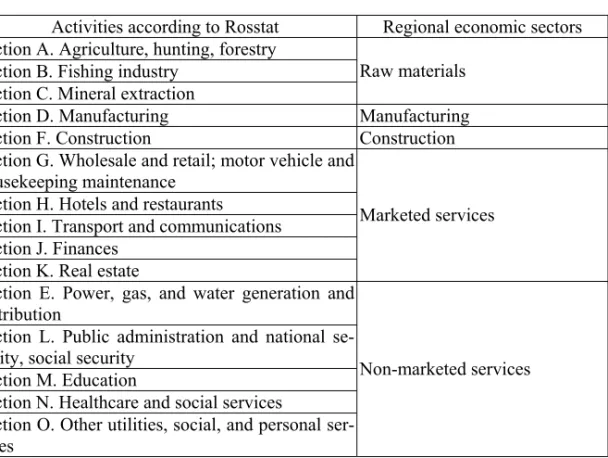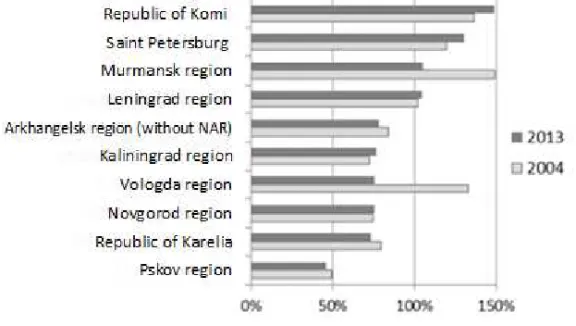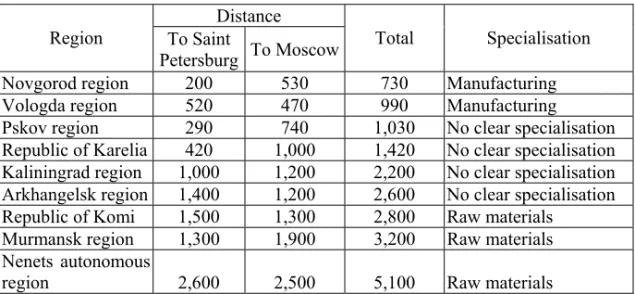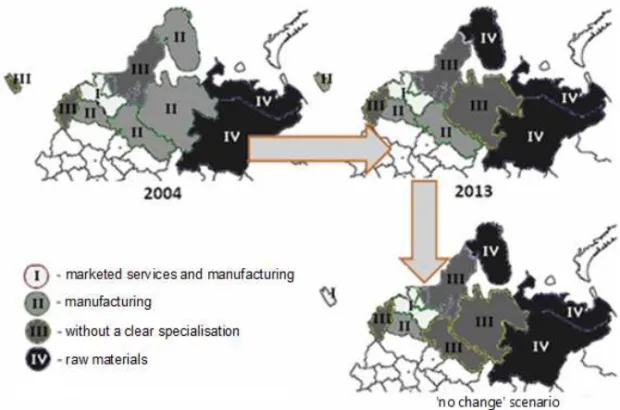This paper identifies and explains trends in the economic transformations in the Russian Northwest (NWFD). It studies changes in the structure of the gross regio-nal product (GRP) and economic specia-lization of the NWFD regions. The authors suggest approaches to managing structural changes in the economies of the NWFD regions. The authors propose a new method for the identification of the regional eco-nomic specialization based on the regional economy sectoral development rate. The article describes a methodology for iden-tifying the development of the regional eco-nomic sectors using the gross value added index calculated per capita and per sector against the national average. The article presents the analysis of the structural chan-ges in the NWFD gross regional product. The proposed gross value added index helps to identify the upward and downward trends in each sector compared to the national ave-rage. Based on this analysis, the authors describe the nature of changes in the NWFD sectoral specialisation, which cor-related with the distance to large economic cores — Moscow and St. Petersburg. The authors prove that the economic develop-ment of the Northwest macroregion follows the core/periphery pattern. The regional economy structure depends on the position of a given region in relation to the core. Concrete approaches to managing struc-tural changes in the economies of perip-hery regions are proposed.
Key words: economic space transfor-mation, core-periphery, spatial inequality, structure of gross regional product
Introduction
Numerous studies supported by vast data demonstrate that the devel-opment of a modern economic system is characterised by spatial non-unifor-mity [2; 8; 13] manifested in economic activities concentrating in agglomera-tions with periphery regions lagging STRUCTURAL CHANGES
IN THE ECONOMY
OF THE RUSSIAN
NORTHWEST:
SPATIAL DIMENSION
N. Kolesnikov
*O. Tolstoguzov
**
Karelian Research Centre of the Russian Academy of Sciences, Russia
50 A. Nevskogo pr., Petrozavodsk, 185030, Russia.
Submitted on February 23, 2016.
doi: 10.5922/2079-8555-2016-2-2
behind. This results in a certain degree of polarisation of economic space and imbalance between regional economic structures, i.e. the development of a
polar regional specialisation in certain industries.
Different aspects of spatial non-uniformity in Russia have been dis-cussed in numerous publications. An attempt to review relevant works was made by K.P. Glushchenko [1]. A comprehensive analysis of economic ac-tivity concentration and regional specialisation is presented in a monograph by S.N. Rastvortseva [6]. The latter suggests classifying regions based on the regional specialisation index and distinguishes between two groups – those with high and low index values. Regions with a high specialisation in-dex are further divided into two subgroups: regions engaged in extracting industries and all the others. At the same times, subgroups specialising in the other economic sectors, for instance, manufacturing and services, do not comprise individual categories in this classification, which might complicate interregional specialisation comparisons.
An analysis of spatial concentration of economic activities in Russia, based on most relevant statistics (as of 2011 inclusive), is presented in an arti-cle by E.A. Kolomak [4]. One of the parameters considered is gross regional product (GRP), but the author does not analyse the regional GRP structure.
The Northwestern federal district (NWFD) includes one of the largest national agglomerations (Saint Petersburg), scarcely populated and remote regions, and those occupying a middle position between the two. Thus, the NWFD is a representative territory for studying the processes of economic space transformation.
The spatial non-uniformity of economic development of NWFD regions is the focus of a study by L.I. Rozanova and M.V. Moroshkina [7], where the interregional comparison is based on investment activity. There are few international studies into the economic development of NWFD regions. However, it is worth mentioning an article by J. Kortelainen and P. Ran-nikko [16], which considers a local economic development model in the pe-riphery border regions of the Russian Northwest and focuses on the timber industry in two municipalities.
This work aims to identify and interpret the trends in the economic space transformation in the NWFD based on an analysis of changes in GRP struc-ture and regional economic specialisation and developing approaches to managing structural changes in the economies of periphery regions.
Methods
This study is based on Rosstat statistics on the GRP structure of each re-gion. The key parameter is GRP per capita by industry. The period under consideration — 2004—2013 — was chosen based on the availability of relevant data.
Table 1
Activities grouped by sectors
Activities according to Rosstat Regional economic sectors Section . Agriculture, hunting, forestry
Section . Fishing industry Section . Mineral extraction
Raw materials
Section D. Manufacturing Manufacturing
Section F. Construction Construction
Section G. Wholesale and retail; motor vehicle and housekeeping maintenance
Section . Hotels and restaurants Section I. Transport and communications Section J. Finances
Section K. Real estate
Marketed services
Section Е. Power, gas, and water generation and distribution
Section L. Public administration and national se-curity, social security
Section M. Education
Section N. Healthcare and social services
Section O. Other utilities, social, and personal ser-vices
Non-marketed services
The Raw materials sector comprises activities focusing on extracting natural resources or utilising them. The Marketed sector includes production of services provided in open (competitive) markets. The Non-marketed sec-tor comprises activities focused on producing services provided in markets characterised by price regulation. In our classification, Manufacturing and construction coincide with the respective activities identified by Rosstat.
The Rosstat data is presented as nominal GRP. To take into account the inflation factor and exclude the effect of macroeconomic processes, regional values of GRP per capita by industry were compared against the national average in the year under consideration:
ij
ij j
GVA
i GVA I
GVA
/
/
*100%
where ij GVA
I is the gross value added index of the ith sector in the jth region,
%; GVAij is the gross added value of the ith sector in the jth region, roubles.;
j stands for the population of the j th
region; GVAi for the gross value added of the ith sector in Russia, roubles; P for the population of Russia.
as compared to the national average. In this work, this index will be referred to as the gross value added index.
Calculating a series of GVA index values for 2004—2013 made it possi-ble to identity trends towards the strengthening and weakening of each re-gional economic sector as compared to the national trend. The analysis made it possible to track changes in the industrial specialisation of NWFD regions.
It is important to make a methodological remark about certain aspects of the NWFD economic space taxonomy. Statistics considers the city of Saint Petersburg and the Leningrad region as two separate regions. Here, we ex-amine them as a single region due to the need to ensure comparability of the studied regions within a comparative analysis of their industry structure. Of course, treating a large highly urbanised city and a region comprising both urbanised and non-urbanised territories as equal analysis units is not entirely appropriate, yet in a broader sense treating Saint Petersburg and the Lenin-grad region as a single unit maintains the principle of spatial continuity.
Results
Analysing time series of the GVA per capita values shows that they tend to increase, as compared to the national average, in the Republic of Komi, Saint Petersburg, and the Leningrad and Kaliningrad regions. A pronounced downward trend is observed in the Vologda and Murmansk regions. GRP does not exceed 80% of the national average in the Republic of Karelia and the Novgorod and Arkhangelsk regions and 50% in the Pskov region. GRP changes in these regions suggest that it is contained within that range (fig. 1). Leaders in the absolute aggregate GRP values are the Republic of Komi, Saint Petersburg, and the Leningrad region.
Distribution of NWFD regions by the absolute value of and changes in aggregate GRP per capita follows the core/periphery logic. High GRP and upward trends are observed in the core — Saint Petersburg and the Lenin-grad region. Low GRP and stable or downward trends are observed in the periphery regions. At the same time, two remote NWFD regions do not fol-low the core/periphery pattern (when aggregate GRP per capita is conside-red). These are the Republic of Komi and the Kaliningrad region. In these regions, GRP per capita tends to increase as compared to the national avera-ge. In the Republic of Komi, its absolute value is much higher than the natio-nal average. To identify the factors affecting these phenomena, let us anatio-nalyse the structure of and changes in GRP in NWFD regions.
The results of processing the statistics necessary for analysing the GRP structure of NWFD regions are shown in fig. 2. Based on the development of certain economic sectors in 2013, NWFD regions can be divided into the following four groups.
Group 1 comprises regions specialising in marketed services and manu-facturing. In the NWFD, these are only Saint Petersburg and the Leningrad region. In these sectors, GVA per capita is 1.5 times the national average.
Group 2 consists of regions specialising in manufacturing. This sector is the only one where value added per capita is above the national average. In the NWFD, such territories are the Vologda, Novgorod, and Kaliningrad gions (fig. 2). However, the marketed services sector is weaker in these re-gions than that of group 1 (Saint Petersburg and the Leningrad region), and its performance is below the national average. The contribution of raw mate-rials is insignificant — relative GVA per capita is between half and third of the national average. In the Vologda region, GVA per capita was decreasing steadily in manufacturing as compared to the national average — from 295% in 2004 to 145% in 2013. If this trend continues, the Vologda region will lose its manufacturing specialisation. In the Kaliningrad region, GVA in marketed services is approaching the national average. If this continues, the Kaliningrad region will join group 1.
Group 3 brings together regions without a clear specialisation. No eco-nomic sectors of these regions demonstrate performance above the national average, i.e. GVA per capita in all regional sectors is below the national av-erage (probably, with the exception of non-marketed cervices sectors). This category includes the Republic of Karelia and the Pskov and Arkhangelsk regions (without the Nenets autonomous region) (see fig. 2). The only sector, whose GVA per capita approaches the national average is non-marketed ser-vices.
non-marketed services marketed services manufacturing raw materials
Analysing the specialisation of each NWFD region in the context of its geographical position, one can see that region's specialisation correlates with its spatial position in relation to Russia’s two economic cores — Saint Pe-tersburg and Moscow, the closest to the NWFD regions (table 2).
Table 2
Distance to economic cores and regional specialisation, km
Distance Region To Saint
Petersburg To Moscow
Total Specialisation
Novgorod region 200 530 730 Manufacturing
Vologda region 520 470 990 Manufacturing
Pskov region 290 740 1,030 No clear specialisation
Republic of Karelia 420 1,000 1,420 No clear specialisation Kaliningrad region 1,000 1,200 2,200 No clear specialisation Arkhangelsk region 1,400 1,200 2,600 No clear specialisation Republic of Komi 1,500 1,300 2,800 Raw materials Murmansk region 1,300 1,900 3,200 Raw materials Nenets autonomous
region 2,600 2,500 5,100 Raw materials
Therefore, the above classification can be supplemented with the de-scription of the geographical position for each region. The core of the NWFD is Saint Petersburg and the Leningrad region — the second largest centre of Russia. Its economic structure is dominated by high value added sectors. The Novgorod and Vologda regions are classed as ‘near’ periphery, which describes both their geographical position and economic structure. Firstly, the Novgorod and Vologda regions are the closest to the regional core in terms of economic structure, since they have retained their manufac-turing specialisation. ‘Remote’ periphery regions include the Arkhangelsk region, Pskov region, and the Republic of Karelia. They are geographically remote from economic cores, whereas their economic structure lacks a clear specialisation in either high-GVA or raw materials sectors. The ‘far-flung’ periphery includes the Murmansk region, the Republic of Komi, and the Ne-nets autonomous region — the most remote territories from the economic cores. They are located a significant distance from Moscow and Saint Pe-tersburg. Their economic structure is opposite to that of the core, since they specialise in raw materials. An exclave with a special economic zone regime, the Kaliningrad region is a separate case.
NWFD, the Kaliningrad region is becoming a territory specialising in mar-keted services and manufacturing. The Novgorod region will retain its manu-facturing specialisation but the Vologda region is likely to lose it (fig. 3).
Fig. 3. Changes in NWFD regions’ specialisation
The Kaliningrad region is the only exception from the general trend of high value sectors gravitating towards the core. This phenomenon can be explained by the region’s advantageous position as compared to the other NWFD regions, the functioning of the special economic zone regime on its territory, its border position [3] and involvement in transboundary value chains.
Mapped visualisation simplifies the perception of information (fig. 3) but does not necessarily reflect data accuracy. Thus, it is important to describe the non-uniformity of economic structure in the NWFD in quantitative terms. For this, let us identify the difference in the development of different economic sectors between groups of regions occupying opposite positions along the core/periphery scale — Saint Petersburg and the Leningrad region, on the one hand, and the ‘far-flung’ periphery, on the other. Let us assume that the difference is expressed in the correlation between the GVA indices for marketed services, manufacturing, and raw materials. The results of the calculations are shown in figure 4.
Fig. 4. GVA indices of the core and periphery regions of the NWFD
Raw materials are becoming increasingly dominant in the ‘far-flung’ pe-riphery of the NWFD, which is proven by the relevant GVA index growth from 325% in 2004 to 392% in 2013 (fig. 4). In the core region of the NWFD, the index value is rather stable, ranging from 13 to 18%. Develop-ment of the raw materials sector is accompanied by the divergence of the core and periphery. However, this time, the core is lagging behind.
Our analysis shows that concentration of high value added sectors in the macroregion core and raw materials specialisation of remote regions tend to increase.
Therefore, transformations of the economic space of the NWFD follow the core/periphery pattern, which manifests in the polarisation of the eco-nomic structure of the core and periphery regions.
Conclusions and recommendations
Not unlike other peripheries, Russia’s northwestern periphery (especially along the outer borders) undergoes global transformation [5]. Although they cannot compete with agglomerations in terms of added value, investment, and household spending, periphery regions play an important role in cultiva-tion and ‘retencultiva-tion’ of territories. Russia’s Northwest has strong economic ties with European countries and thus contributes to achieving an important geopolitical objective — promoting and implementing competitive projects for territory development — in the conditions of systemic challenges and strong competition from the relevant projects of neighbouring countries.
Polarisation of the economic space accompanied by excessive centralisa-tion of power increases differences between the developed core and the weakened periphery. This results in a number of typical issues: depopula-tion, weak economic activity, budget deficit, low investment potential, pov-erty and social differentiation, insufficient urbanisation, and the obsoles-cence and insufficiency of infrastructure. Polarised development leads to a decrease in the quality of labour force, out-migration, reduction in economic activity, and finally, transition from periphery to downward transition re-gions. This results in Russian regional policy focusing on the issues of so-cioeconomic and spatial development of periphery regions.
A deficiency in the traditional approach is underestimation of systemic risks and inability to identify key competences that can be translated into fundamental benefits through organised economic activities and develop-ment of new tools that would take into account economic cycles and external global challenges faced by periphery regions [10]. This manifests in the ab-sence of innovative hi-tech industries, which would give rise to new markets of hi-tech products and services and rapid dissemination of technology in traditional and new industries.
European research focusing on the development of periphery territories identifies innovation as the key element of a region’s economic develop-ment. For instance, D. Doloreux [12], K. Onsager [18], A. Isaksen and J. Karlsen [14], D. Baumgartner [11], and S. Virkkala [20] stress the low density of economically active population, weak interregional competition, small local market, and a narrow knowledge base. F. Tödtling and M. Trippl also emphasise a ‘thin’ regional innovation system.
We believe that economic modernisation of a periphery region is stalled by systemic limitations — low liquidity, insufficient investment attractiveness, and institutional particularities resulting in uneven distribution of investment (its concentration in agglomerations). To ensure liquidity, it is necessary to repro-duce certain nodes of the economic space, including transport and engineering infrastructure, social infrastructure, healthcare, and education.
Based on the results obtained, we offer recommendations for the devel-opment of a regional economic policy that, on the one hand, would not stall the objective processes of economic space polarisation and, on the other, would stimulate the development of economic activities in periphery regions based on their unique advantages and human capital.
A strategic analysis makes it possible to formulate three approaches to the structural modernisation of a periphery region’s economy. The first one suggests selecting a strategy for strengthening a region’s position in relevant markets based on increasing its specialisation and focusing efforts on se-lected economic sectors and technologies accompanied by an increase in production efficiency in view of inclusion into value chains and attraction of foreign investment. A specialisation is selected for cooperation and inclusion into interregional and international production chains and financial flows. This suggests a focus on the investment process, its organisational and insti-tutional support with an emphasis on value added by resident agents within production chain, specialisation, and cooperation. As V.I. Chasovsky stres-ses, ‘it is also possible to encourage miniaturisation of activities, since a small hi-tech enterprise can be integrated into regions of different ranks’ [9, p. 166].
The second approach suggests its structural diversification based on the development of technology and industrial, transport, and logistics infrastruc-ture and inclusion into global value chains. The expected result is creating a foundation for innovation diffusion, adoption of innovative management tools, economic diversification, increasing investment attractiveness, and finally securing innovation and technology development. Special attention is paid to developing measures to take advantage of external development op-portunities (external investment and externalities).
The choice between specialisation and diversification as conceptual ap-proaches to regional economic development has been studied by many au-thors. However, there is no definite answer as to whether any of these ap-proaches is superior to the other. At the same time, T. Kemeny and M. Storpe [15] stress that strengthening a region’s sepcialisation has a positive correlation with the level of salaries. Some even believe that specialisation and diversification are interrelated processes [17].
The third approach has not been formulated clearly. However, its ele-ments can be used within the first and second approaches, namely, the crea-tion of funccrea-tional zone, new technologies, and technology platforms substi-tuting traditional elements of value chains in the conditions of local commu-nity consolidation. This imperative — the creation of an innovative econ-omy, — necessitates joining the efforts of business, science, and the states. Priorities, strategic research programmes, and roadmaps for introducing in-novation infrastructure (technology platforms, industrial parks, etc.) are de-vised based on the above consideration and a long-term forecast for science, technology, and breakthrough area development.
References
1.Gluschenko, K. P. 2010, Issledovaniya neravenstva po dokhodam mezhdu ros-siyskimi regionami [Studies on income inequalities among Russian regions], Region: ekonomika i sotsiologiya [Region: Economics and Sociology], no.4, p. 88—119.
2.Doklad o mirovom razvitii 2009: novyy vzglyad na ekonomicheskuyu geo-grafiyu [World development report 2009: Reshaping Economic Geography], 2009, Moscow.
3.Kolesnikov, N. G. 2012, Prigranichnost' i periferiynost' kak faktory ekonomi-cheskogo razvitiya regiona [Borderness and peripherality as factors of economic de-velopment of a region], Sever i rynok: formirovaniye ekonomicheskogo poryadka
[North and Market: Formation of Economic Order], T. 3, no. 31, p. 117.
4.Kolomak, Ye. A. 2014, Prostranstvennaya kontsentratsiya ekonomicheskoy aktivnosti v Rossii [Spatial concentration of economic activities in Russia], Pros-transtvennaya Ekonomika [Spatial Economics], no. 4, p. 82—99.
5.Savelyev, Yu. V., Tolstoguzov, O. V. (eds.) 2015, Osobennosti sotsial'no-ekonomicheskogo razvitiya i modernizatsii prigranichnogo regiona [Features of socio-economic development and modernization of a border region], Petrozavodsk.
6.Rastvortseva, S. N. 2013 Upravleniye razvitiyem protsessov kontsentratsii eko-nomicheskoy aktivnosti v regione: podkhody novoy ekoeko-nomicheskoy geografii [Re-gional economic activities development management: new economic geography ap-proach], Moscow.
7.Rozanova, L. I., Moroshkina, M. V. 2015, Analiz vliyaniya protsessa kont-sentratsii na razvitiye regionov Severo-zapadnogo federal'nogo okruga [Analysis of the impact of processes of concentration on the development of North-West Federal District regions], Ekonomicheskiy analiz: teoriya i praktika [The economic analysis: theory and practice], no. 22, p. 52—62.
8.Tolstoguzov, O. V. 2011, Differentsiatsiya regionov Rossii i problemy raz-vitiya prigranichnykh regionov [Differentiation of Russian regions and issues of de-velopment of border regions], Problemy strategii i taktiki regional'nogo razvitiya
[Problems of strategy and tactics of regional development], T. 2, p. 153—162. 9.Chasovskiy, V. I. 2015, Key Directions of Sectoral and Spatial Changes in the Russian Industry, Balt. Reg., no. 3, p. 121—134. DOI: 10.5922/2079-8555-2015-3-10.
10. Shishkin, A. I., Shishkin, A. A. 2015, Upravleniye ekonomicheskimi prot-sessami v regione (analitika na osnove praktiki strategicheskogo planirovaniya v Karelii) [Management of economic processes in a region (analytics based on the practice of strategic planning in Karelia], Saint-Petersburg.
11. Baumgartner, D., Pütz, M., Seidl, I. 2013, What kind of entrepreneurship dri-ves regional development in European non-core regions? A literature review on em-pirical entrepreneurship research, European Planning Studies, no. 21, p. 1095—1127.
12. Doloreux, D., Dionne, S. 2008, Is regional innovation system development possible in peripheral regions? Evidence from the case of La Pocatiere, Entrepre-neurship & Regional Development, no. 20, p. 259—283.
13. Gardiner, B., Martin, R. L., Tyler, P. 2013, Spatially unbalanced growth in the British economy. Journal of Economic Geography, 13, p. 889—928.
14. Isaksen, A., Karlsen, J. 2013, Can small regions construct regional advan-tages? The case of four Norwegian regions. European Urban and Regional Studies, no. 20, p. 243—257.
16. Kortelainen, J., Rannikko, P. 2015, Positionality Switch: Remapping Re-source Communities in Russian Borderlands, Economic Geography, T. 91, Vol. 1, p. 59—81.
17. Noseleit, F. 2015, The Role of Entry and Market Selection for the Dynamics of Regional Diversity and Specialization, Regional Studies, T. 49, Vol. 1, p. 76—94.
18. Onsager, K., Isaksen, A., Fraas, M., Johnstadt, T. 2007, Technology cities in Norway: Innovating in glocal networks, European Planning Studies, no. 15, p. 549—566.
19. Tödtling, F., Trippl, M. 2005, One size fits all? Towards a differentiated re-gional innovation policy approach, Research Policy, no. 34, p. 1203—1219.
20. Virkkala, S. 2007, Innovation and networking in peripheral areas — a case study of emergence and change in rural manufacturing, European Planning Studies, no. 15, p. 511—529.
About the authors
Dr. Nikolai Kolesnikov, Senior Research Fellow, the Institute of Economics, Karelian Research Centre of the Russian Academy of Sciences, Russia.
E-mail: nikolaikolesnikov@yandex. ru
Prof. Oleg Tolstoguzov, Head of the Department of Regional Economic Policy, the Institute of Economics, Karelian Research Centre of the Russian Academy of Sciences, Russia.
E-mail: olvito@mail.ru
To cite this article:





